Behavior of Two-Chord Steel–Concrete Composite Columns under Axial Compression
Abstract
:1. Introduction
2. Experimental Program
2.1. Column Models
2.2. Material Properties
2.3. Test Setup
3. Results of the Experiments
3.1. TCHST Specimens
3.2. TCCFST Specimens
3.3. Comparative Analysis of the Test Results
4. The Design Strength of TCCFST Members
4.1. Axial Capacity
4.1.1. Eurocode 4
4.1.2. AISC 360-16 Code
4.1.3. DBJ/T13-51 Code
4.2. Discussion of the Results
5. Numerical Modeling
5.1. FEM Model
5.2. Material Models for Steel and Concrete
5.3. Verification Study
6. Conclusions
- (1)
- In this research, steel with a 600 N/mm2 yield stress was used in combination with concrete with a cylinder compressive strength of 95 N/mm2. During the experiments, both materials reached their maximum strength at approximately the same strain level; thus, the full potential of the high-strength steel and the high-strength concrete was utilized.
- (2)
- The load-bearing capacity of the hollow two-chord columns improved by around 1.74 times due to the concrete infill, while the presence of the concrete infill in the chords increased the slenderness of the column by 16%.
- (3)
- The filled specimens exhibited a stiffer behavior than and a similar deformational capacity to the hollow steel tube column models. The failure of the column models occurred as a result of the global buckling of the chords, the crushing of the filled concrete, and steel yielding.
- (4)
- A load distribution analysis indicated that composite action between all cross-section parts was achieved. It was observed that 36% of the load was carried by the concrete, while 64% of the load was carried by the steel tube.
- (5)
- A hoop stress effect was registered in the steel tube; i.e., a plane state of stress was formed, which led to the enhanced properties of the concrete due to the confining effect provided by the steel tube.
- (6)
- The behavior of the TCCFST column could be divided into two parts, mainly the behavior before and after reaching the yield stress of the steel tube. In the first part, the structural response of the column was linear, and, after reaching the yield stress, the buckling of the chords occurred.
- (7)
- All three analyzed structural codes gave relatively good forecasts of the axial compressive capacity of the TCCFST column. The Eurocode 4 and AISC 360 predictions were proven to be underestimated. The DBJ/T13-51 design code gave the best predictions and, thus, could be recommended for the calculation of the design strength of TCCFST columns.
- (8)
- A numerical analysis can be successfully applied if the appropriate material models are correctly entered into the FEM model. The FEM model showed good predictions of strength, stresses, deformations, and buckling.
Author Contributions
Funding
Institutional Review Board Statement
Informed Consent Statement
Data Availability Statement
Acknowledgments
Conflicts of Interest
Abbreviations
| RC | reinforced concrete |
| CFST | concrete-filled steel tube |
| TCHST | two-chord hollow steel tube |
| TCCFST | two-chord concrete-filled steel tube |
| DT | displacement transducer |
| SG | strain gauge |
| COV | coefficient of variation |
| EC | Eurocode |
| FEM | finite element method |
References
- Landović, A.; Bešević, M. Experimental Research on Reinforced Concrete Columns Strengthened with Steel Jacket and Concrete Infill. Appl. Sci. 2021, 11, 4043. [Google Scholar] [CrossRef]
- Han, L.H.; Li, W.; Bjorhovde, R. Developments and advanced applications of concrete filled steel tubular (CFST) structures: Members. J. Constr. Steel Res. 2014, 100, 211–228. [Google Scholar] [CrossRef]
- Ellobody, E.; Young, B.; Lam, D. Behaviour of normal and high strength concrete-filled compact steel tube circular stub columns. J. Constr. Steel Res. 2006, 62, 706–715. [Google Scholar] [CrossRef]
- Kawano, A.; Matsui, C.; Sakino, Y. An experimental study on the elasto-plastic behavior and deformability of concrete-filled tubular truss beam-columns under cyclic loading. J. Struct. Constr. Eng. Archit. Inst. Jpn. 1996, 482, 141–150. (In Japanese) [Google Scholar] [CrossRef] [PubMed]
- Kawano, A.; Matsui, C. The deformation capacities of parallel chord trusses with concrete filled tubular chords. J. Struct. Constr. Eng. Archit. Inst. Jpn. 1999, 522, 129–135. (In Japanese) [Google Scholar] [CrossRef]
- Kawano, A.; Sakino, Y. Seismic resistance of CFT trusses. Eng. Struct. 2003, 25, 607–619. [Google Scholar] [CrossRef]
- Ou, Z.; Chen, B.; Hsieh, K.H.; Halling, M.W.; Barr, P.J. Experimental and analytical investigation of concrete filled steel tubular columns. J. Struct. Eng. 2011, 137, 635–645. [Google Scholar] [CrossRef]
- Yang, Y.-F.; Liu, M.; Fu, F. Experimental and numerical investigation on the performance of three-legged CFST latticed columns under lateral cyclic loadings. Thin-Walled Struct. 2018, 132, 176–194. [Google Scholar] [CrossRef]
- Yang, Y.-F.; Liu, M.; Hou, C.; Bie, X.-M. Behaviour of four-legged square CFST latticed members under lateral cyclic loading. J. Constr. Steel Res. 2019, 156, 54–74. [Google Scholar] [CrossRef]
- Zheng, L.-Q.; Li, G.-H.; Zhou, J.-Z.; Wang, Z.-Z. Behavior of three-chord concrete-filled steel tube built-up columns subjected to eccentric compression. J. Constr. Steel Res. 2021, 177, 106435. [Google Scholar] [CrossRef]
- Yuan, H.-H.; She, Z.-M.; Wu, Q.-X.; Huang, Y.-F. Experimental and parametric investigation on elastoplastic seismic response of CFST battened built-up columns. Soil Dyn. Earthq. Eng. 2021, 145, 106726. [Google Scholar] [CrossRef]
- Yuan, H.-H.; Wu, Q.-X.; Huang, Y.-F. Experimental and theoretical studies on the seismic performance of CFST battened built-up column piers. Eng. Struct. 2020, 206, 110099. [Google Scholar] [CrossRef]
- Chen, L.; Zuo, R.; Zhang, Y.; Yang, D.; Li, J.; Wu, Z.; Ji, X. Study on Seismic Performance Optimization of Assembly Concrete-Filled Steel Tubular (CFST)-Laced Piers. Sustainability 2023, 15, 8318. [Google Scholar] [CrossRef]
- Javidan, F.; Heidarpour, A.; Zhao, X.-L.; Minkkinen, J. Application of high strength and ultra-high strength steel tubes in long hybrid compressive members: Experimental and numerical investigation. Thin-Walled Struct. 2016, 102, 273–285. [Google Scholar] [CrossRef]
- Nassirnia, M.; Heidarpour, A.; Zhao, X.-L.; Minkkinen, J. Innovative hollow corrugated columns comprising corrugated plates and ultra high-strength steel tubes. Thin-Walled Struct. 2016, 101, 14–25. [Google Scholar] [CrossRef]
- Luo, Y.; Zhao, Y.; Chen, Y.; Lin, X.; Yan, J. Experimental Studies on Seismic Performance of UHPSFRC-Filled Square Steel Tubular Columns. Buildings 2022, 12, 798. [Google Scholar] [CrossRef]
- Wei, J.; Xie, Z.; Zhang, W.; Yang, Y.; Luo, X.; Chen, B. Axial compressive property of UHPC plate-CFST laced composite columns. Case Stud. Constr. Mater. 2022, 16, e01085. [Google Scholar] [CrossRef]
- Guo, Y.; Wang, J. Instability behavior and application of prismatic multi-tube latticed steel column. J. Constr. Steel Res. 2009, 65, 12–22. [Google Scholar] [CrossRef]
- Xu, M.; Zhou, T.; Chen, Z.; Li, Y.; Bisby, L. Experimental study of slender LCFST columns connected by steel linking plates. J. Constr. Steel Res. 2016, 127, 231–241. [Google Scholar] [CrossRef]
- Zhou, T.; Chen, Z.; Liu, H. Seismic behavior of special shaped column composed of concrete filled steel tubes. J. Constr. Steel Res. 2012, 75, 131–141. [Google Scholar] [CrossRef]
- AISC 360-16; Specification for Structural Steel Buildings. American Institute of Steel Construction: Chicago, IL, USA, 2016.
- DBJ/T13-51-2010; Technical Specification for Concrete-Filled Steel Tubular Structures. The Construction Department of Fujian Province: Fuzhou, China, 2010. (In Chinese)
- EN 1994-1-1; Eurocode 4: Design of Composite Steel and Concrete Structures. Part 1–1: General Rules and Rules for Buildings. Comité Européen de Normalisation (CEN): Brussels, Belgium, 2004.
- AS5100.6-2004; Bridge Design, Part 6: Steel and Composite Construction. Standards Australia: Sydney, Australia, 2004.
- SRPS EN 12390-1; Testing Hardened Concrete—Part 1: Shape, Dimensions and Other Requirements for Specimens and Moulds. Institute for Standardization of Serbia: Belgrade, Serbia, 2021.
- SRPS EN 12390-2; Testing Hardened Concrete—Part 2: Making and Curing Specimens for Strength Tests. Institute for Standardization of Serbia: Belgrade, Serbia, 2019.
- SRPS EN 12390-3; Testing Hardened Concrete—Part 3: Compressive Strength of Test Specimens. Institute for Standardization of Serbia: Belgrade, Serbia, 2019.
- SRPS EN 12390-5; Testing Hardened Concrete—Part 5: Flexural Strength of Test Specimens. Institute for Standardization of Serbia: Belgrade, Serbia, 2019.
- SRPS EN 12390-7; Testing Hardened Concrete—Part 7: Density of Hardened Concrete. Institute for Standardization of Serbia: Belgrade, Serbia, 2019.
- SRPS EN ISO 6892-1; Metallic Materials—Tensile Testing—Part 1: Method of Test at Room Temperature. Institute for Standardization of Serbia: Belgrade, Serbia, 2019.
- EN 1993-1-1; Eurocode 3: Design of Steel Structures. Part 1-1: General Rules and Rules for Buildings. Comité Européen de Normalisation (CEN): Brussels, Belgium, 2005.
- Han, L.-H.; Liu, W.; Yang, Y.-F. Design calculations on concrete-filled thin-walled steel tubes subjected to axially local compression. In Proceedings of the 12th International Symposium on Tubular Structures, Shanghai, China, 8–10 October 2008; pp. 85–91. [Google Scholar]
- Han, L.H.; Zhao, X.L.; Tao, Z. Tests and mechanics model of concrete filled SHS stub columns, columns and beam-columns. Steel Compo. Struct. 2001, 1, 51–74. [Google Scholar] [CrossRef]
- Yang, Y.F.; Han, L.H. Experiments on rectangular concrete-filled steel tubes loaded axially on a partially stressed cross-sectional area. J. Constr. Steel Res. 2009, 65, 1617–1630. [Google Scholar] [CrossRef]
- Chen, B.; Lai, Z.; Yan, Q.; Varma, A.H.; Yu, X. Experimental behavior and design of CFT-RC short columns subjected to concentric axial loading. J. Struct. Eng. 2017, 143, 04017148. [Google Scholar] [CrossRef]
- Hoang, A.L.; Fehling, E. A review and analysis of circular UHPC filled steel tube columns under axial loading. Struct. Eng. Mech. 2017, 61, 417–430. [Google Scholar] [CrossRef]
- Chiew, S.P.; Cai, Y.Q. Design of High Strength Steel Reinforced Concrete Columns: A Eurocode 4 Approach; CRC Press: Boca Raton, FL, USA; Taylor & Francis Group: Boca Raton, FL, USA, 2018; ISBN 978-0815384601. [Google Scholar]
- ANSYS Inc. ANSYS Theory Reference; ANSYS Inc.: Canonsburg, PA, USA, 2016. [Google Scholar]
- Lai, Z.; Varma, A.H. Effective stress-strain relationships for analysis of noncompact and slender filled composite (CFT) members. Eng. Struct. 2016, 124, 457–472. [Google Scholar] [CrossRef]
- Shaker, F.M.F.; Daif, M.S.; Deifalla, A.F.; Ayash, N.M. Parametric Study on the Behavior of Steel Tube Columns with Infilled Concrete—An Analytical Study. Sustainability 2022, 14, 14024. [Google Scholar] [CrossRef]
- Liew, J.Y.R.; Xiong, D.X. Ultra-high strength concrete filled composite columns for multi-storey building construction. Adv. Struct. Eng. 2012, 15, 1487–1503. [Google Scholar] [CrossRef]
- Samani, A.K.; Attard, M.M. A stress-strain model for uniaxial and confined concrete under compression. Eng. Struct. 2012, 41, 335–349. [Google Scholar] [CrossRef]
- Katwal, U.; Tao, Z.; Hassan, K.; Wang, W.-D. Simplified Numerical Modeling of Axially Loaded Circular Concrete-Filled Steel Stub Columns. J. Struct. Eng. 2017, 143, 04017169. [Google Scholar] [CrossRef]
- Nwankwo, C.O.; Ede, A.N. Flexural strengthening of reinforced concrete beam using a natural fibre reinforced polymer laminate: An experimental and numerical study. Mater. Struct. 2020, 53, 142. [Google Scholar] [CrossRef]
- Milašinović, D.D.; Landović, A. Rheological-dynamic model for load-bearing capacity of composite columns due to concrete core failure. Mater. Struct. 2023, 56, 75. [Google Scholar] [CrossRef]



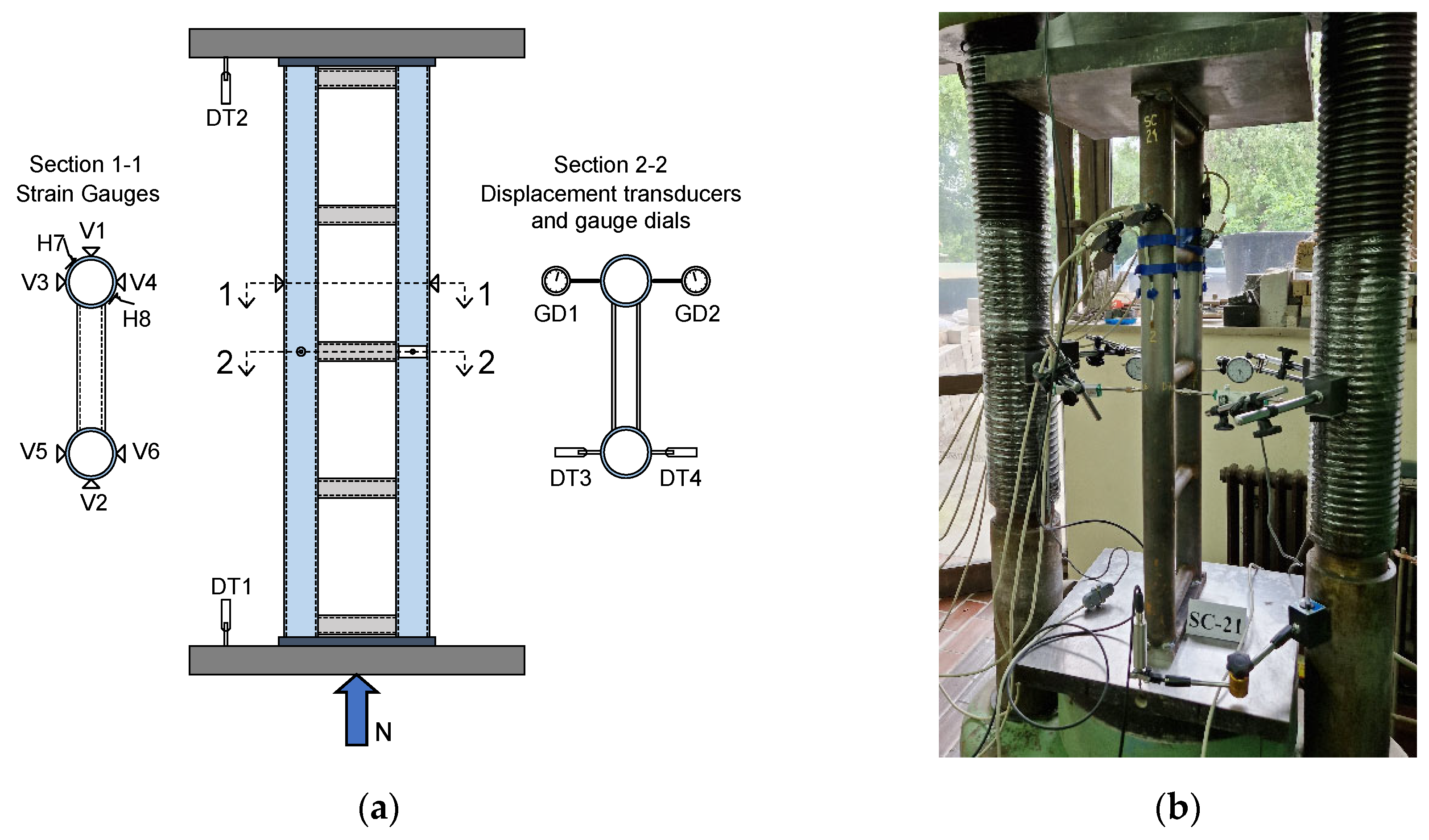

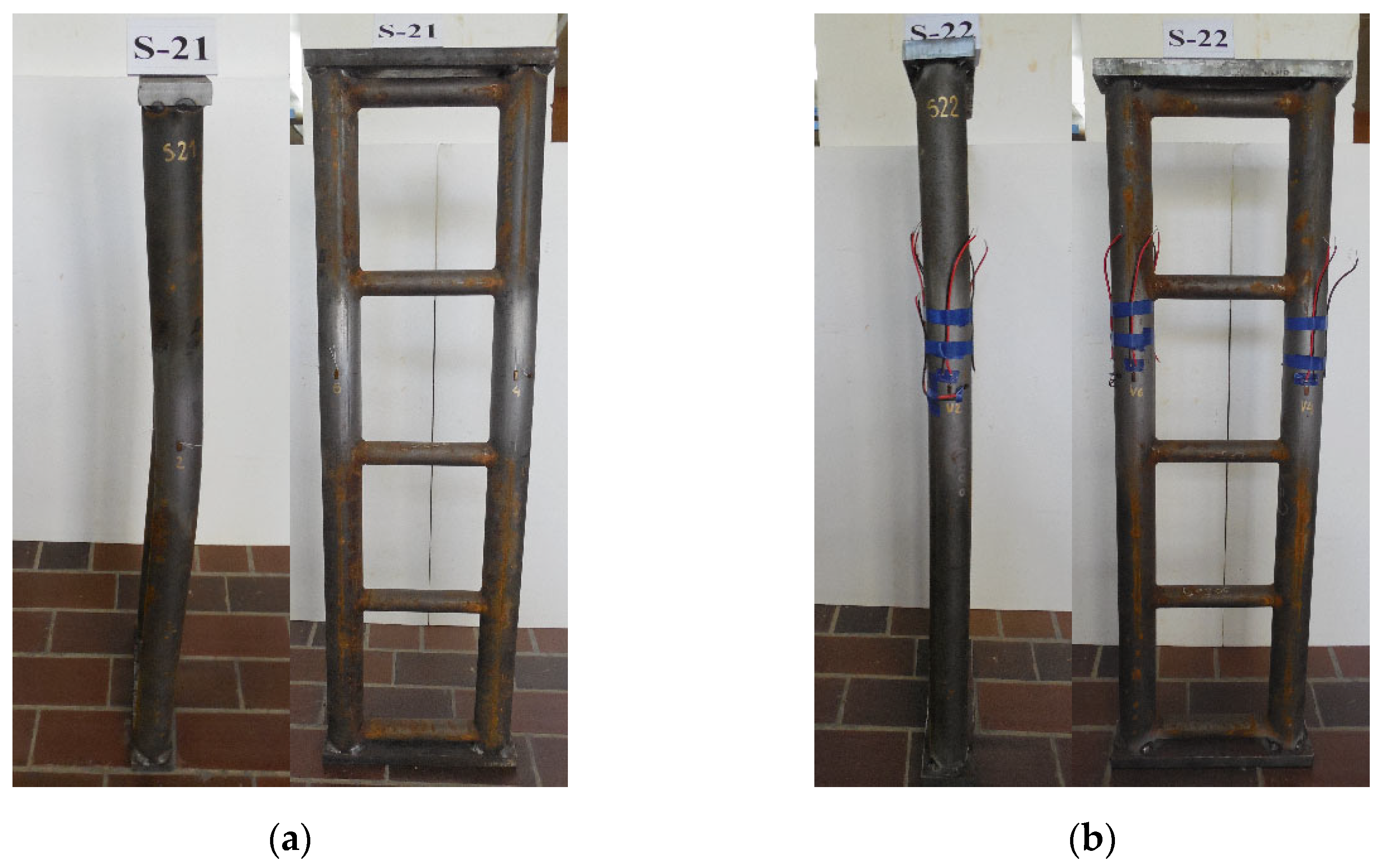
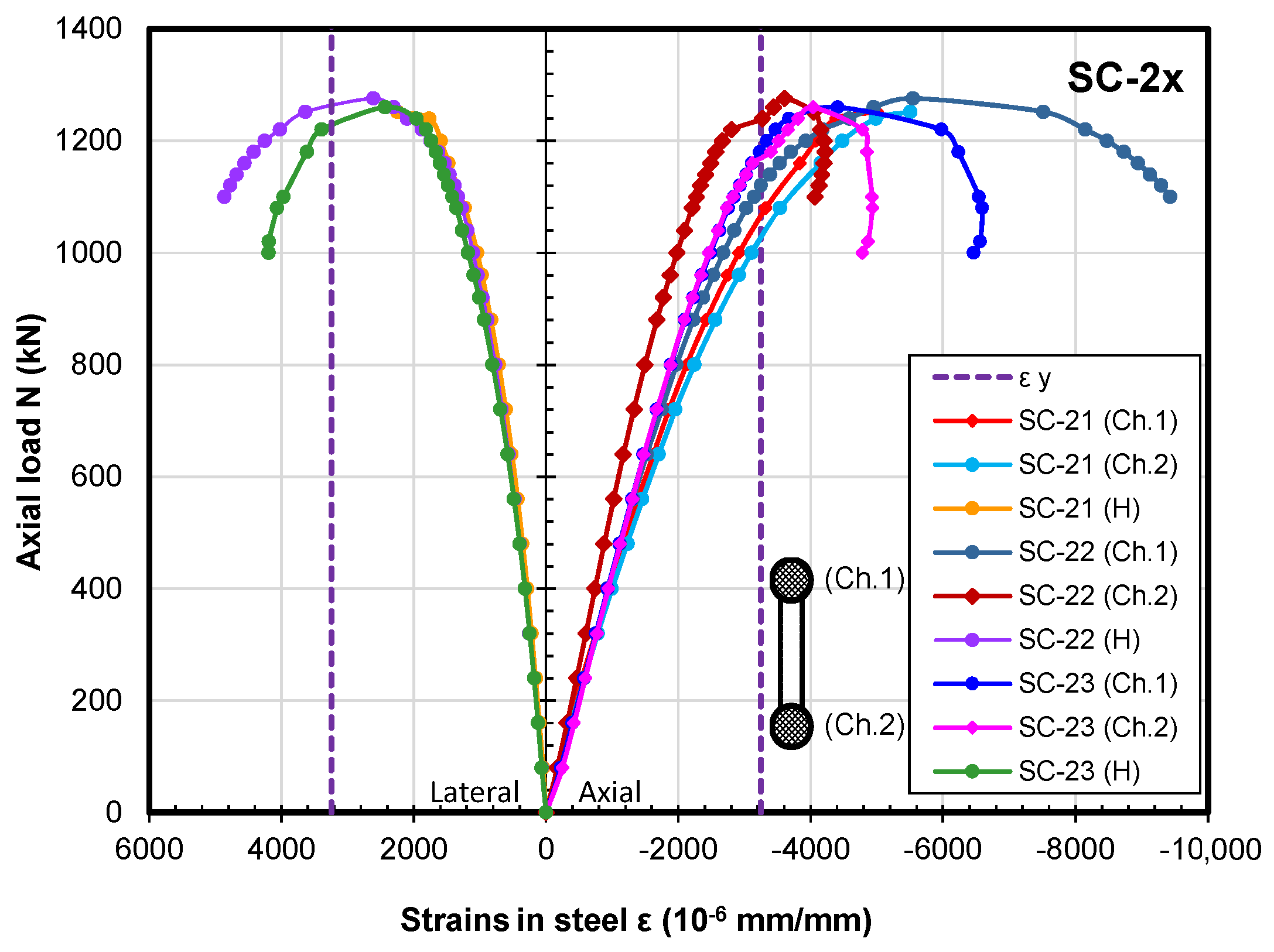
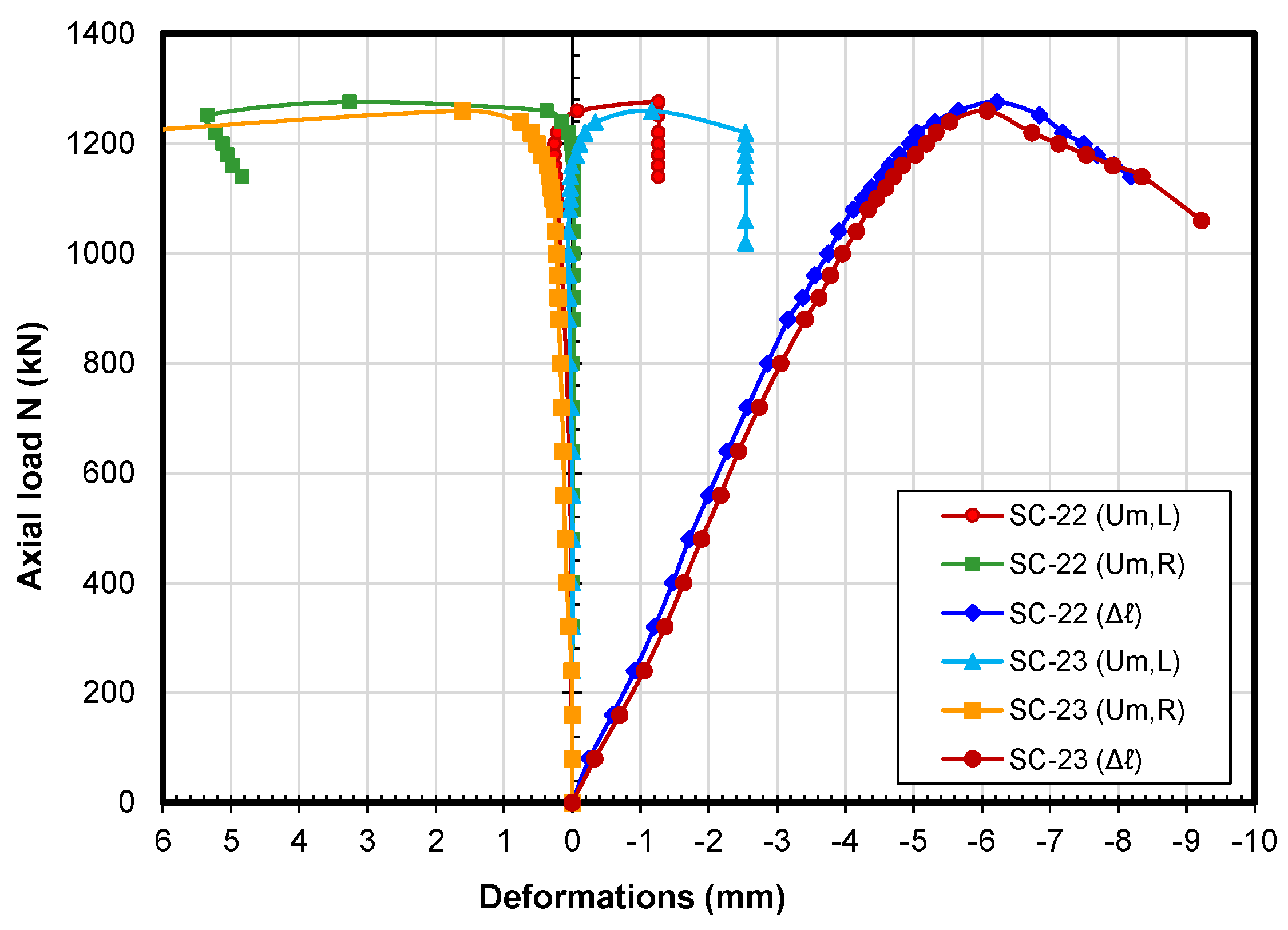

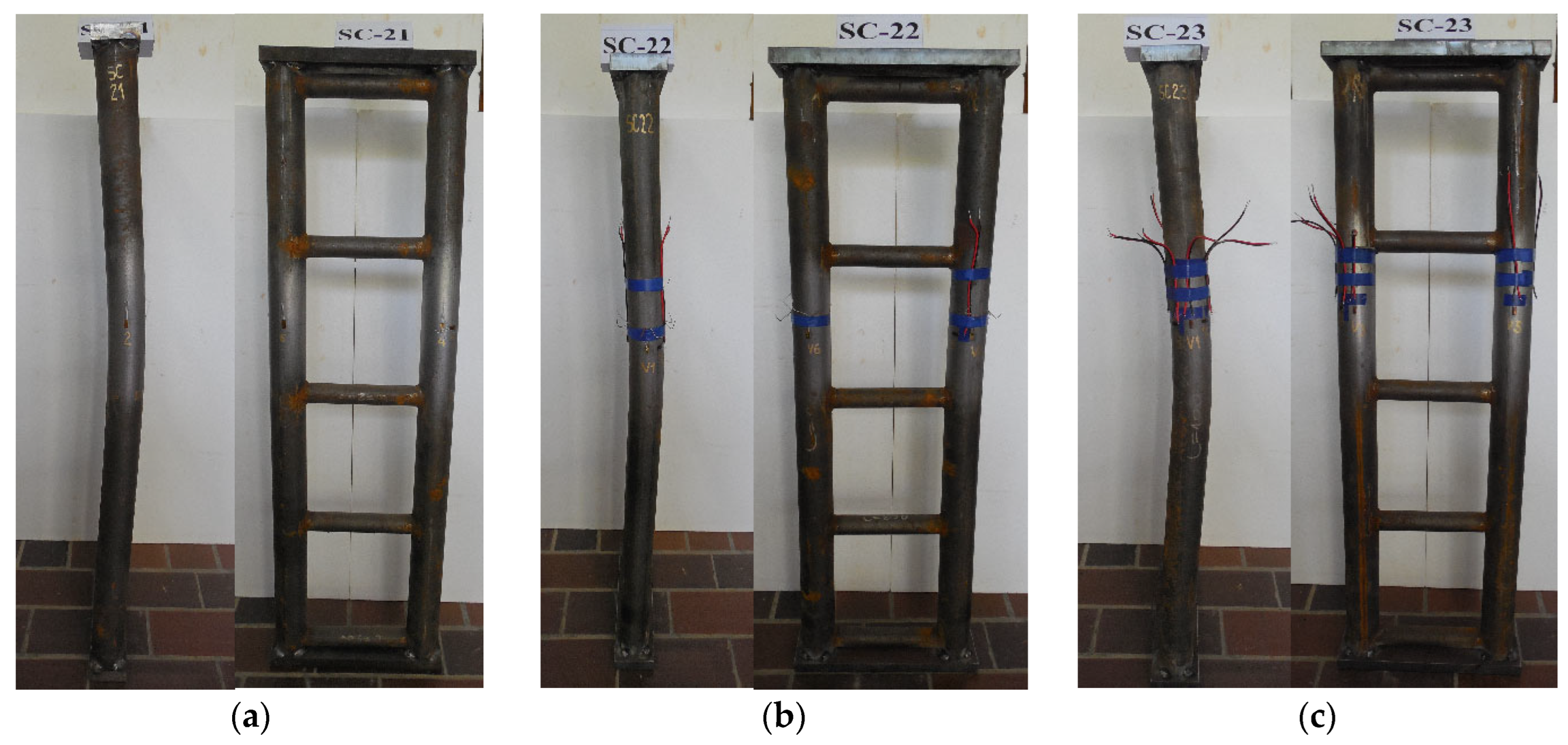

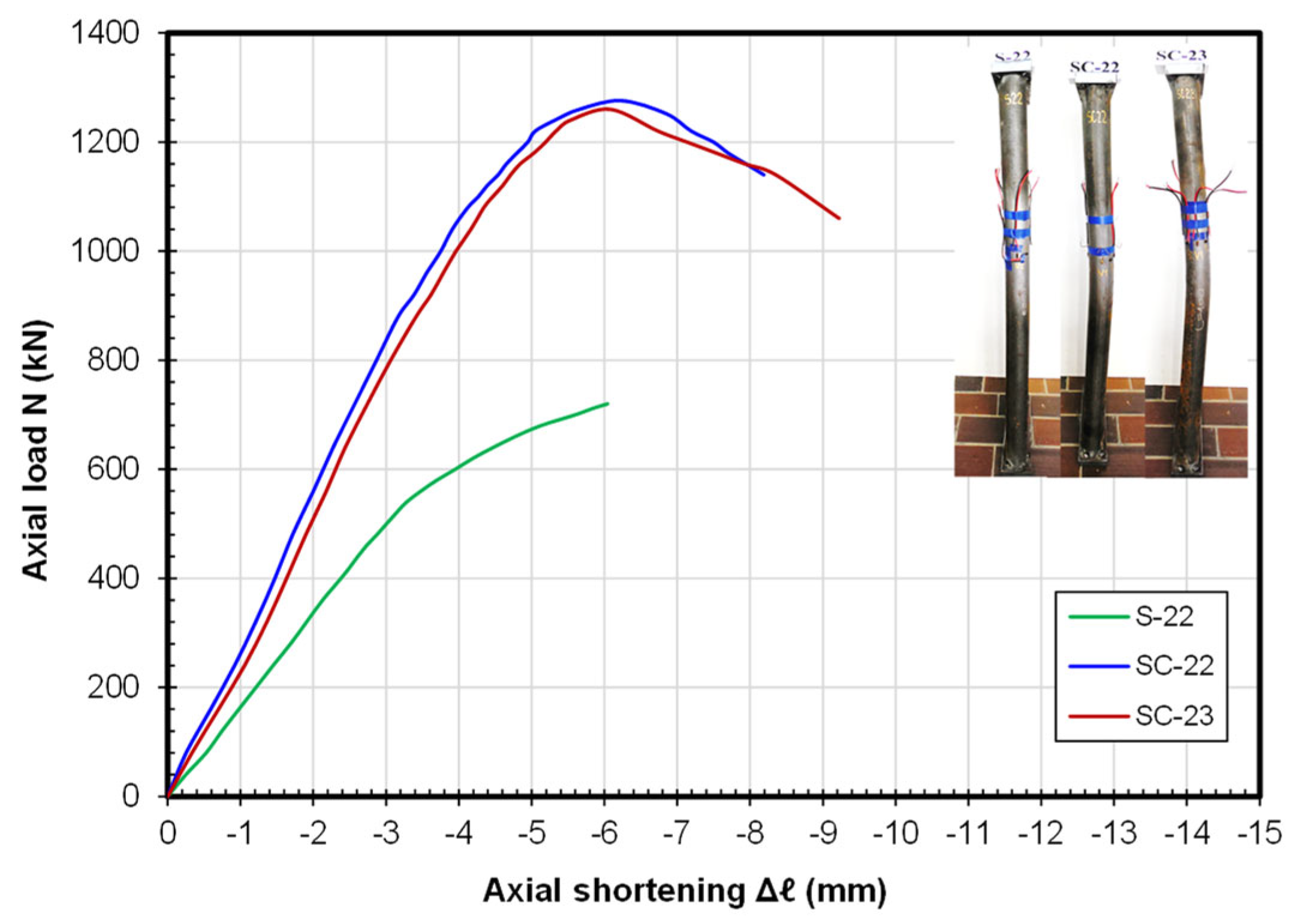
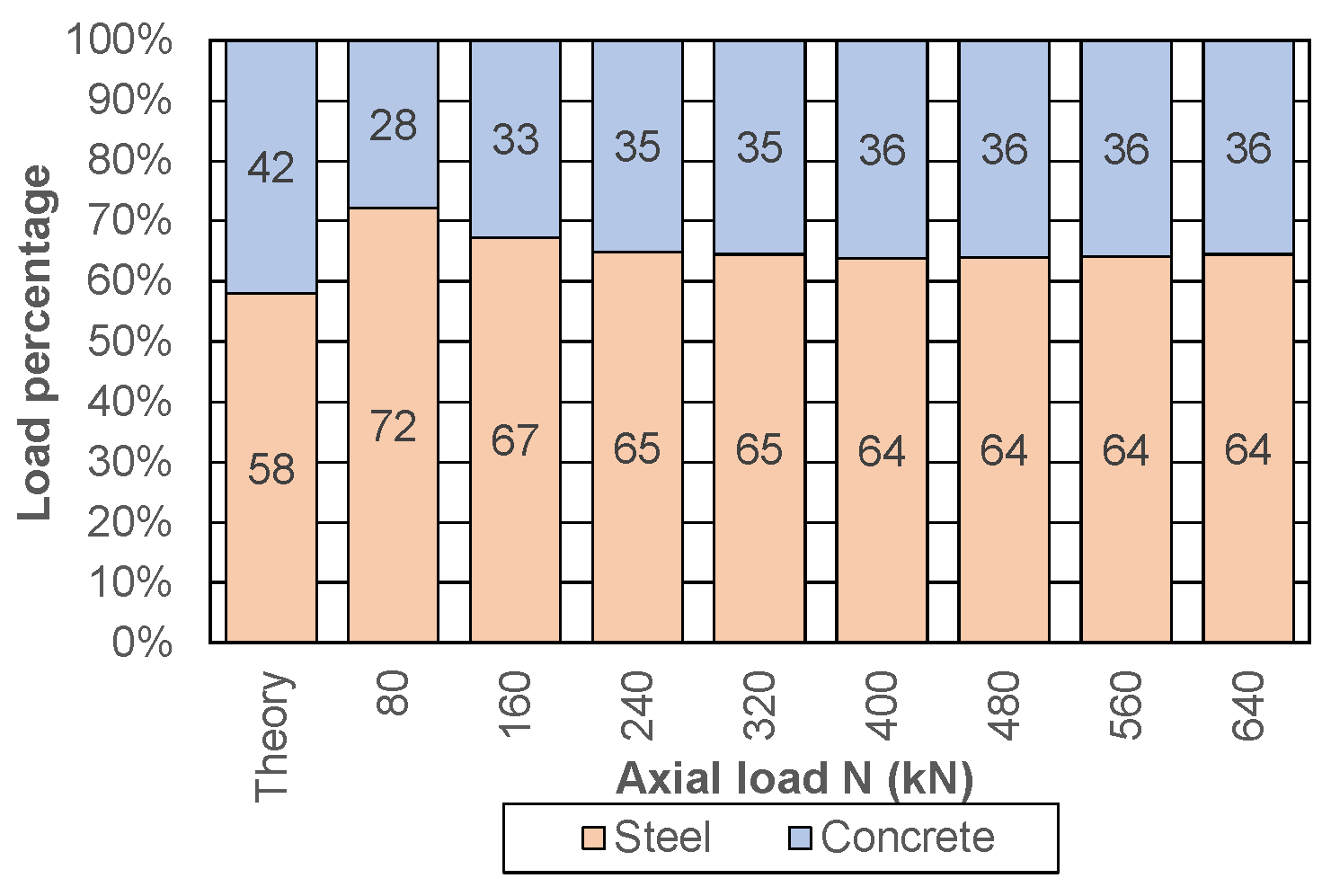

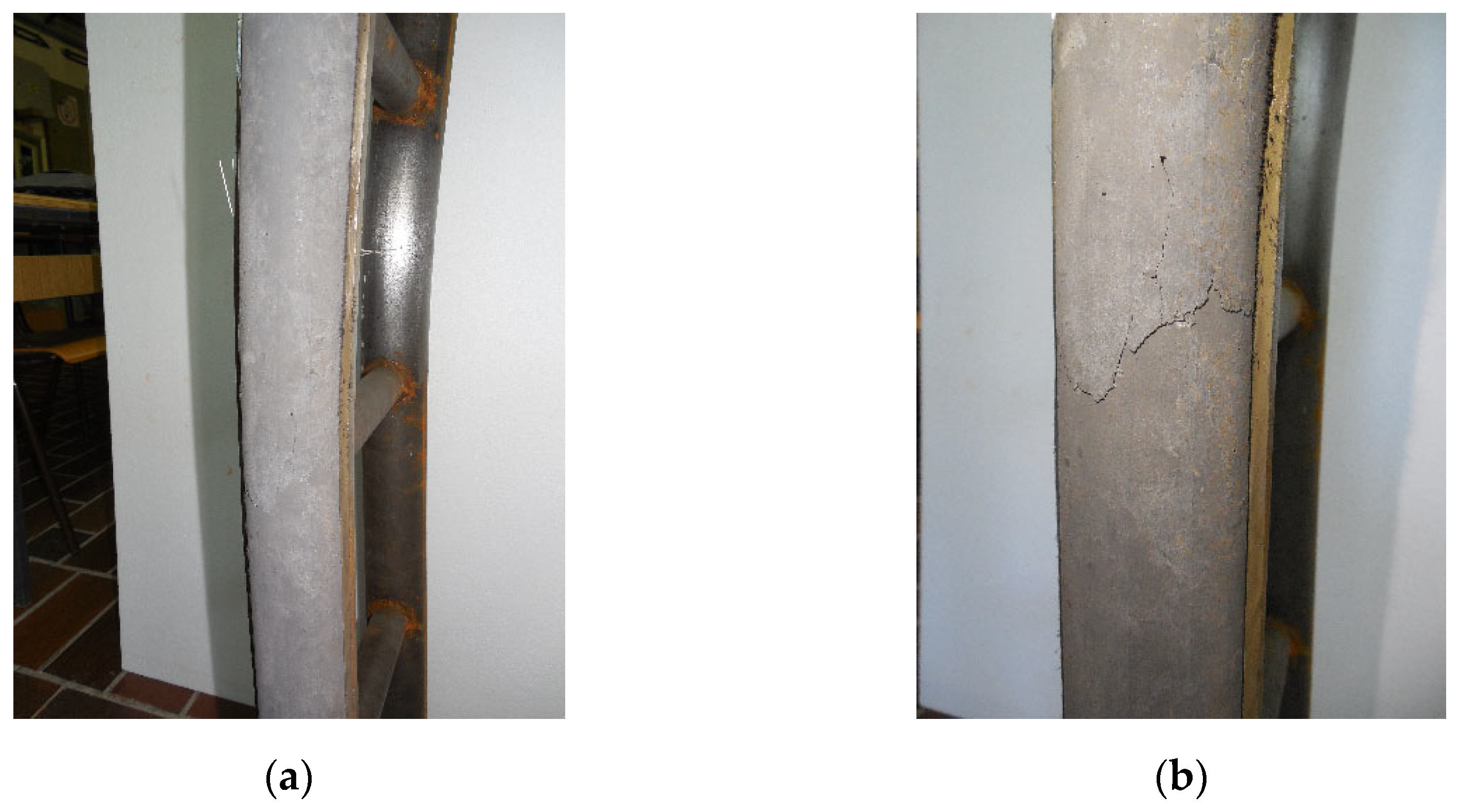

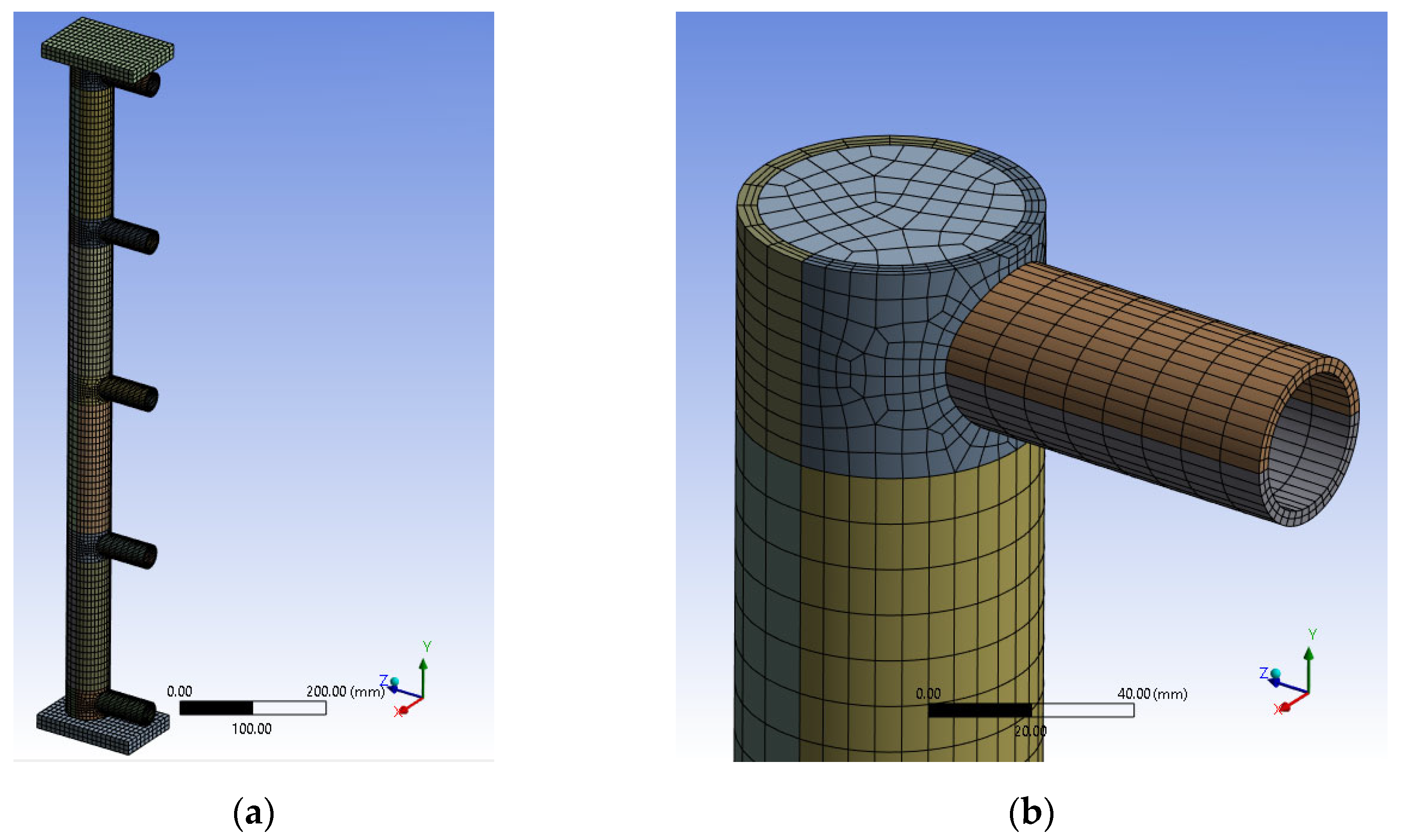


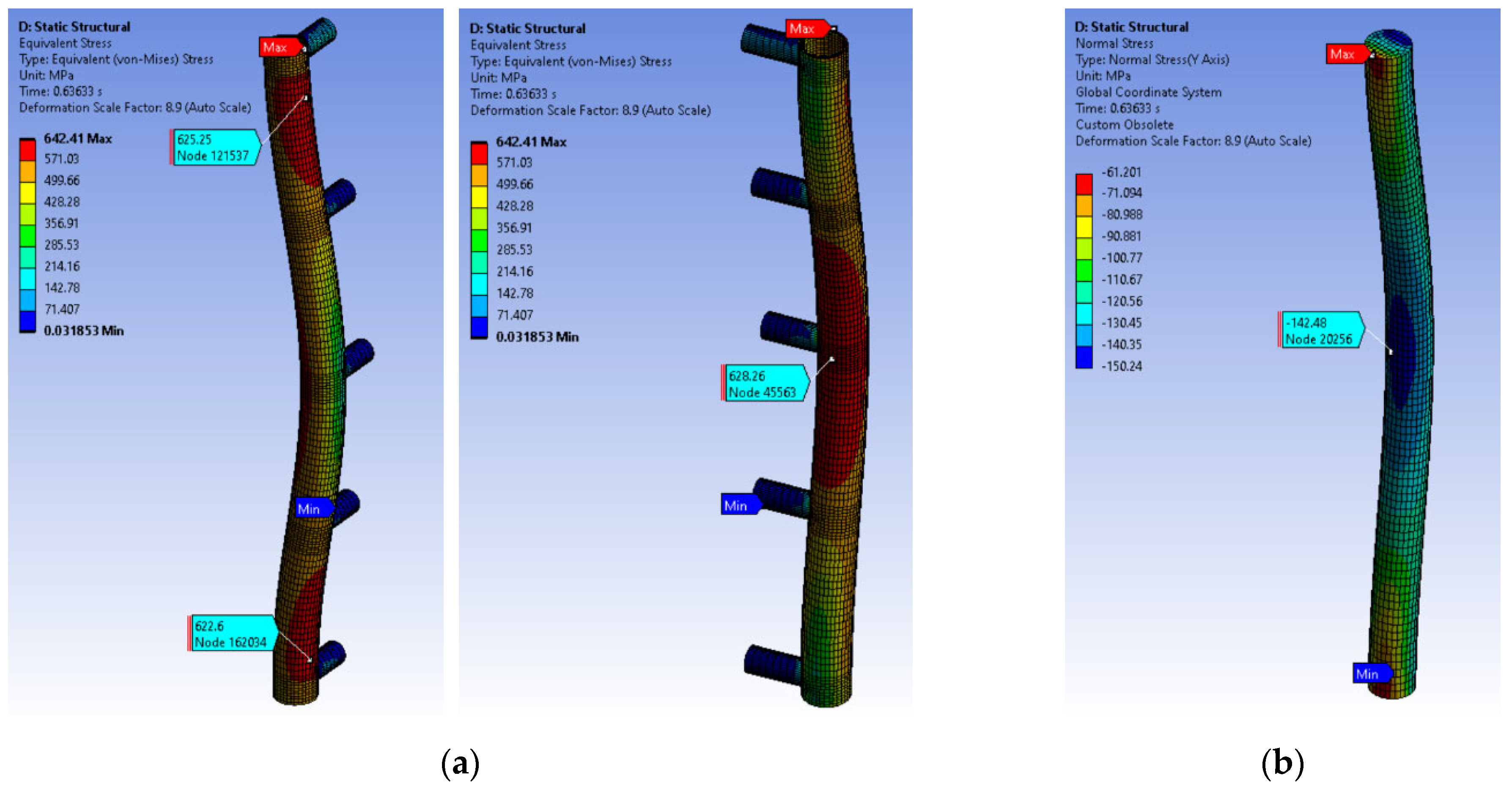
| No. | Label | A (mm2) | I (mm4) | λn (−) | ξ | Nu (kN) |
|---|---|---|---|---|---|---|
| 1 | S-21 | 1415 | 563,458 | 25 | - | 732 |
| 2 | S-22 | 1415 | 563,458 | 25 | - | 720 |
| 3 | SC-21 | 2451 | 740,538 | 29 | 2.76 | 1252 |
| 4 | SC-22 | 2451 | 740,538 | 29 | 2.76 | 1276 |
| 5 | SC-23 | 2451 | 740,538 | 29 | 2.76 | 1260 |
| fcu (N/mm2) | fc (N/mm2) | fck (N/mm2) | fct (N/mm2) | ρ (kg/m3) | μc (−) | Ec (GPa) |
|---|---|---|---|---|---|---|
| 128.0 | 95.2 | 71.6 | 13.2 | 2485 | 0.22 | 44.6 |
| Class | D (mm) | t (mm) | fy (N/mm2) | fu (N/mm2) | fu/fy | Es (GPa) | μs (−) | δ (%) |
|---|---|---|---|---|---|---|---|---|
| S600 | 60.3 | 4.0 | 600 | 640 | 1.07 | 190 | 0.30 | 11.1 |
| Hollow Group S21 and S22 | Filled Group SC21, SC22, and SC23 | |
|---|---|---|
| Nu,exp (kN) | 726 | 1263 |
| Sn (kN) | 8.49 | 12.22 |
| COV (%) | 1.17 | 0.97 |
| ks (-) | - | 1.74 |
| Nu,e | Nu,EC4 | Nu,EC4/Nu,ex. | Nu,AISC | Nu,AISC/Nu,ex. | Nu,DBJ | Nu,DBJ/Nu,ex. | Nu,FEM | Nu,FEM/Nu,ex. |
|---|---|---|---|---|---|---|---|---|
| 1263 | 1004 | 0.80 | 766 | 0.61 | 1342 | 1.06 | 1273 | 1.01 |
Disclaimer/Publisher’s Note: The statements, opinions and data contained in all publications are solely those of the individual author(s) and contributor(s) and not of MDPI and/or the editor(s). MDPI and/or the editor(s) disclaim responsibility for any injury to people or property resulting from any ideas, methods, instructions or products referred to in the content. |
© 2023 by the authors. Licensee MDPI, Basel, Switzerland. This article is an open access article distributed under the terms and conditions of the Creative Commons Attribution (CC BY) license (https://creativecommons.org/licenses/by/4.0/).
Share and Cite
Kovač-Striko, J.; Landović, A.; Čeh, A.; Bešević, M. Behavior of Two-Chord Steel–Concrete Composite Columns under Axial Compression. Appl. Sci. 2023, 13, 12634. https://doi.org/10.3390/app132312634
Kovač-Striko J, Landović A, Čeh A, Bešević M. Behavior of Two-Chord Steel–Concrete Composite Columns under Axial Compression. Applied Sciences. 2023; 13(23):12634. https://doi.org/10.3390/app132312634
Chicago/Turabian StyleKovač-Striko, Josip, Aleksandar Landović, Arpad Čeh, and Miroslav Bešević. 2023. "Behavior of Two-Chord Steel–Concrete Composite Columns under Axial Compression" Applied Sciences 13, no. 23: 12634. https://doi.org/10.3390/app132312634





